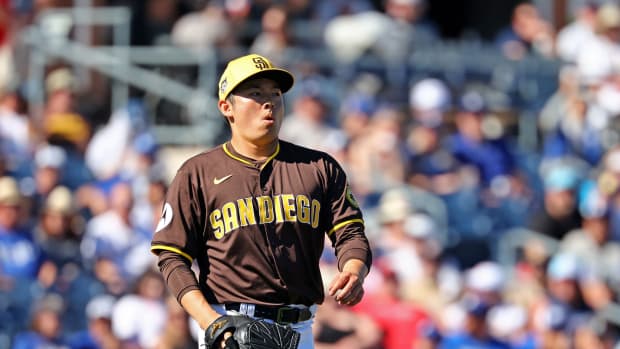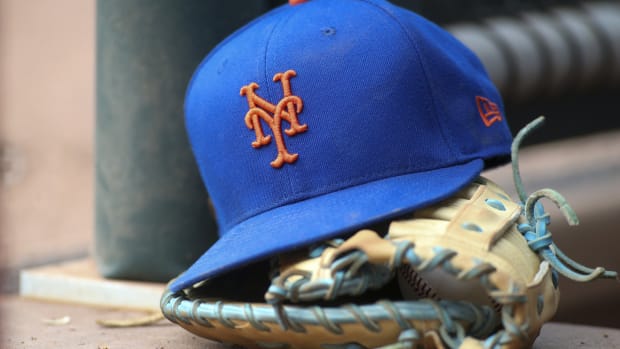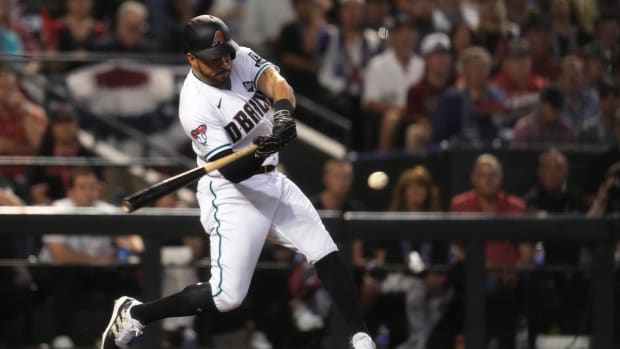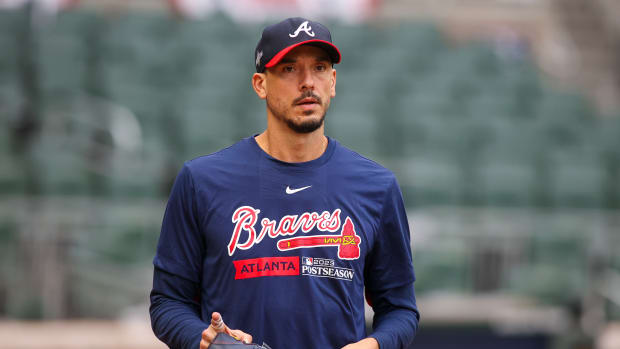With position in field to be determined, Astros gamble on Gattis
The Braves' housecleaning continued Wednesday with the trade of catcher Evan Gattis to the Astros for a trio of prospects that includes flame-throwing righty starter Mike Foltynewicz, third baseman Rio Ruiz and righthander Andrew Thurman. The Astros will also receive minor league righthander James Hoyt in the deal. Gattis, whose .487 slugging percentage over the last two years led all catchers regardless of playing time, follows fellow lineup mainstays Jason Heyward and Justin Upton out of Atlanta as the Braves continue to look beyond 2015. The Astros, meanwhile, have added a powerful righthanded bat to their lineup, but if reports of their intention to move Gattis out from behind the plate prove accurate, the decision will greatly undermine the value of the player they just acquired.
Winter Report Card: Houston Astros
From Houston's perspective, adding Gattis, who has four team-controlled years remaining and won't be arbitration eligible until after the coming season, gives the team an impressive trio of right-handed sluggers in the heart of its order in designated hitter Chris Carter — who signed a one-year, $4.175 million deal on Wednesday to avoid arbitration — sophomore rightfielder George Springer and Gattis. The latter's 43 home runs over the last two seasons are tied with fellow ex-Brave Brian McCann for the most by a catcher over that span (with Gattis having had 157 fewer PA than McCann in those two seasons). Carter's 37 home runs last year tied him with Giancarlo Stanton for the second-most in the majors, while Springer's 20 home runs in 78 games as a rookie last year came at a rate of 42 per 162 games.
However, like Carter and Springer, Gattis comes with considerable pitch-recognition issues. Carter led the majors with 212 strikeouts in 2014, and he and Springer have both struck out in roughly one third of their plate appearances in the majors. Gattis, who struck out in nearly a quarter of his plate appearances last year, is a contact hitter by comparison. Rather, his primary shortcoming at the plate is a dismal walk rate. Gattis has nearly five times as many strikeouts as unintentional walks in his two major league seasons and has drawn just 36 unintentional passes in 783 career plate appearances (764 if you leave out his seven intentional walks and 12 times hit by a pitch), just one more than Springer drew in 345 PA last year alone.
Gattis is also a sub-par defensive catcher — he threw out just 20 percent of opposing base runners last year against a league-wide rate of 28 percent — an average-at-best pitch framer and among the weaker pitch-blockers in the majors per Baseball Prospectus' numbers. Indeed, with the Braves looking to make room for defense-first catching prospect Christian Bethancourt, Gattis had been penciled in as Upton's replacement in leftfield before Friday's trade. That doesn't mean that Gattis is any more viable in the outfield than behind the plate. If anything, he is less so, which makes the Astros' decision to follow the Braves lead by moving Gattis to left problematic.
Given Gattis' lack of on-base abilities, his poor range in the outfield could significantly undermine his production at the plate. The best-case scenario is something like Nelson Cruz. The worst is a player without a position on a team that has Carter at DH and power prospect Jon Singleton at first base. It would make more sense for the Astros to try to trade incumbent catcher Jason Castro, who has just two team-controlled years remaining, let newly acquired Hank Conger be Gattis' defensive caddy behind the plate, and let Jake Marisnick, a top-100 prospect prior to the 2014 season who was acquired from the Marlins in July, get first crack at the leftfield job.
Little big league: How Jose Altuve became an unlikely batting champ
That could well still be the Astros' intention, with the word of Gattis' move to left as a smokescreen to prevent the gutting of Castro's trade value. Castro, an All-Star in 2013 when he hit .276/.350/.485 with 18 home runs, is a former first-round pick (10th overall in 2008) and top-100 prospect heading into his age-27 season, but is coming off a dismal .222/.286/.366 performance last year. Perhaps the Astros don't want to seem too desperate to trade a player coming off such a poor showing. Or perhaps they would rather see Castro recover some of his value on the field before trading him and moving Gattis back behind the plate. Then again, given the underwhelming performances of Marisnick and Singleton as rookies last year, perhaps they're simply thinking that there will be enough at-bats between first base, leftfield and catcher to make Gattis a full-time presence in the lineup without making him the primary starter at any given position.
• CORCORAN: Does No. 1 farm system ranking spell future success?
As for the Braves, their plan had always been to transition from McCann to Bethancourt. Gattis, who spent three years away from baseball in his early twenties, turned 24 barely two months after being drafted in the 23rd round by the Braves in 2010. He finally reached the majors as a 26-year-old rookie in 2013 and was an unexpected surprise. As a result, the three prospects acquired by the Braves in this deal are very nearly something for nothing in the big picture, as the Braves just traded a 23rd-round pick for the 19th selection in the same draft (Foltynewicz), a second-round pick from 2013 (Thurman) and a fourth-round pick from '12 (Rios).
A's radical roster re-do just part of larger trend around baseball
Foltynewicz (prounounced folt-in-EH-vich) turned 23 in October and was ranked the third-best prospect in the Astros' system by Baseball America in November, behind former No. 1 picks Carlos Correa and Mark Appel. However, despite making his major league debut this past August, he's unlikely to claim a spot in the Braves' rotation in the short term. Foltynewicz can hit triple-digits with his four-seamer, but got more batters to swing and miss with his sinker, curve and changeup after making his major league debut in August. He walked at least 4.5 men per nine innings at every stop between the Sally League and the majors. After getting called up, Foltynewicz struck out just 6.8 men per nine innings and walked half as many while opposing hitters hit .299/.357/.506 against him in an admittedly tiny sample of 18 relief appearances. Given that he didn't impress in Triple-A either (5.08 ERA, 1.46 WHIP, 1.96 K/BB), he's likely headed for a repeat of that level and could ultimately land in the bullpen to stay if he doesn't refine his command in the coming season.
Ruiz, who will turn 21 in May, ranked eighth on that BA list of Astros prospects and is coming off a nice season in the High A California League in which he hit .293/.387/.436 with 82 walks against 91 strikeouts. As with Foltynewicz, there's a lot that remains to be seen with Ruiz. Will he develop more power? Can he stick at third base? How will he handle the jump to Double A this season? Will the blood clots that caused him to miss most of his senior year in high school in 2012 reoccur? He's an intriguing prospect, but with the Astros having acquired fellow third baseman Colin Moran from the Marlins in July, Ruiz was expendable. Moran, a 22-year-old who made a successful jump to Double A upon being acquired by Houston in the six-player Jarred Cosart deal, was the sixth pick in the 2013 draft and ranked one spot ahead of Ruiz on BA's list of Astros prospects in November.
Thurman is a 23-year-old righty and projects as a back-end starter in the majors, but he has yet to pitch above A ball. Hoyt, the other player going to the Astros, is a conventional righty reliever who was plucked out of the independent leagues by the Braves two years ago, cracked Triple A last year and seems likely to return there this year for his age-28 season. Ultimately, neither team gave up a player they couldn't afford to lose, as every player in this deal is a gamble of one kind or another.


































